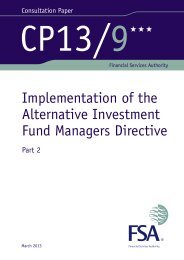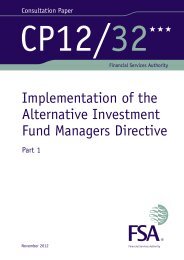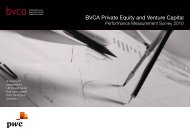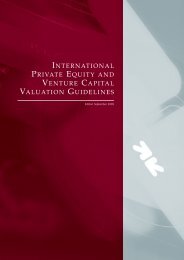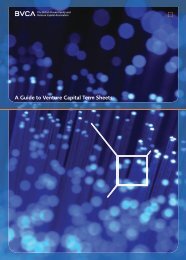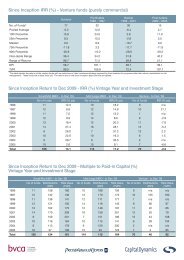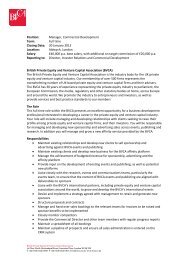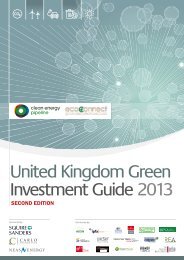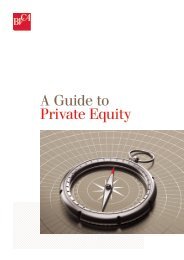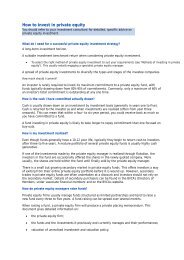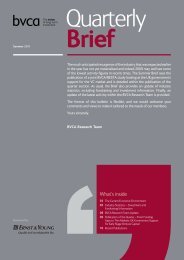BVCA Private Equity and Venture Capital ... - BVCA admin
BVCA Private Equity and Venture Capital ... - BVCA admin
BVCA Private Equity and Venture Capital ... - BVCA admin
You also want an ePaper? Increase the reach of your titles
YUMPU automatically turns print PDFs into web optimized ePapers that Google loves.
Does this allow for greater breakdown of<br />
the data?<br />
Yes. Reducing the number of categories makes<br />
it easier to break out vintage year data by stage<br />
category. From 1996 vintages onwards, vintage<br />
years are analysed by <strong>Venture</strong>, Small/Mid-MBO<br />
<strong>and</strong> Mid/Large MBO stages. Due to some very<br />
small sample sizes, the MBO categories have<br />
had to be combined when comparing with<br />
<strong>Venture</strong>. This further breakdown of vintage year<br />
returns will be useful when benchmarking<br />
funds. It is hoped that this will increase the<br />
usefulness of the survey to investors <strong>and</strong><br />
practitioners alike.<br />
How are the returns calculated?<br />
The primary method for calculating returns is<br />
based on the annualised internal rate of return<br />
(IRR) achieved over a period of time. This<br />
return is based upon the total actual fund cash<br />
flows <strong>and</strong> valuations of the funds at the relevant<br />
period ends <strong>and</strong> the calculation of the change<br />
between them on a per annum basis.<br />
The returns are therefore time- <strong>and</strong> moneyweighted<br />
(often referred to as ‘time line basis’).<br />
The returns are based on fund valuations<br />
provided by the fund manager. How robust<br />
are these numbers?<br />
Sixty-two per cent of the funds surveyed contain<br />
unrealised investments. As part of online<br />
collection, respondents are asked whether<br />
fund valuations have been based on the new<br />
International <strong>Private</strong> <strong>Equity</strong> <strong>and</strong> <strong>Venture</strong> <strong>Capital</strong><br />
Valuation Guidelines <strong>and</strong>, if not, what valuation<br />
method has been used. However, PwC has not<br />
independently confirmed that the International<br />
Guidelines have been adhered to.<br />
It should be remembered that, as with other<br />
asset classes, a valuation provides an interim<br />
‘snapshot’ of performance. The distributing<br />
nature of the vast majority of private equity<br />
funds means that when a fund has made<br />
its final distribution, a pure cash-on-cash<br />
return can be calculated.<br />
What are the International <strong>Private</strong> <strong>Equity</strong><br />
<strong>and</strong> <strong>Venture</strong> <strong>Capital</strong> Valuation Guidelines?<br />
The International Valuation Guidelines were<br />
initially launched in March 2005, having been<br />
developed by the Association Française des<br />
Investisseurs en <strong>Capital</strong> (AFIC), the British<br />
<strong>Private</strong> <strong>Equity</strong> <strong>and</strong> <strong>Venture</strong> <strong>Capital</strong> Association<br />
(<strong>BVCA</strong>) <strong>and</strong> the European <strong>Private</strong> <strong>Equity</strong> <strong>and</strong><br />
<strong>Venture</strong> <strong>Capital</strong> Association (EVCA), <strong>and</strong><br />
<strong>BVCA</strong> <strong>Private</strong> <strong>Equity</strong> <strong>and</strong> <strong>Venture</strong> <strong>Capital</strong> Performance Measurement Survey 2011 57<br />
endorsed by 30 regional <strong>and</strong> national associations,<br />
including the Institutional Limited Partners<br />
Association (ILPA) in the USA. These replaced<br />
the previously widely used <strong>BVCA</strong> Valuation<br />
Guidelines. For more information, please visit:<br />
http://www.privateequityvaluation.com/<br />
Why is the internal rate of return (IRR) used?<br />
The IRR is the most appropriate measure of<br />
return due to the high level of discretion on the<br />
part of the fund manager in determining cash<br />
flows to <strong>and</strong> from the investors <strong>and</strong> the difficulty<br />
in determining portfolio valuations at the date<br />
of each cash flow that would be required in<br />
order to calculate a time-weighted return.<br />
The academic community <strong>and</strong> the CFA Institute<br />
(formerly AIMR – Association of Investment<br />
Management Research) supports the use of the<br />
IRR as the most appropriate measure of private<br />
equity <strong>and</strong> venture capital fund performance.<br />
Can you compare IRRs to the returns<br />
generated by other asset classes?<br />
Most other asset classes, including the WM<br />
Pension Fund Universe <strong>and</strong> other comparative<br />
indices quoted in this report, are calculated as<br />
gross time-weighted returns (TWR) <strong>and</strong> so any<br />
comparison should be done with care. Such TWR<br />
calculations are not possible for private equity<br />
as they require frequent <strong>and</strong> easily obtainable<br />
revaluations <strong>and</strong> assume a low level of manager<br />
discretion in the timing of cash flows.<br />
Is the IRR net or gross?<br />
The private equity return represents the ‘net’<br />
return to investors after costs <strong>and</strong> fees. Provision<br />
is made for performance fees, which would have<br />
been payable if the residual valuation had been<br />
realised at the valuation date. Returns from the<br />
WM Pension Funds Assets <strong>and</strong> FTSE indices,<br />
however, are gross time-weighted returns.<br />
Thus, private equity returns are effectively<br />
understated in comparison.<br />
Why is the net IRR used?<br />
The net IRR is the most appropriate measure<br />
of performance as this is the return that is<br />
generated to the investor. While gross IRRs are<br />
important for measuring individual investments,<br />
the effects of costs <strong>and</strong> fees can significantly<br />
reduce the gross returns when the totality of<br />
the fund is examined.



